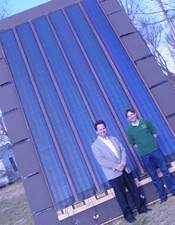UMR gets funding for 2007 solar house
Posted by news
The solar house team at the University of Missouri-Rolla is one of 20 teams that have been selected to receive $100,000 from the U.S. Department of Energy to support the construction of new houses for the 2007 Solar Decathlon.
UMR has designed and built houses for previous Solar Decathlon events, which are typically held every-other year on the National Mall in Washington, D.C., to raise awareness about solar energy.
UMR’s 2005 solar house was trucked back to the Rolla area last fall and put into storage. This month, it will be placed on a foundation in a Rolla neighborhood next to a solar house built in 2002. Like the 2002 house, the 2005 house will be available for rent to students on the UMR Solar House Team.
 |
| Dr. Stuart Baur (left) and UMR graduate student Joel Lamson pose in front of a huge hybrid solar panel, which was tested in Lamson’s backyard in Rolla. |
Eventually, UMR plans to create a small solar village, with several houses placed on university-owned land in close proximity. The houses, which create their own electricity and hot water, are affordable to live in. During the summer months, the houses are actually capable of producing extra energy that can be sold.
According to Dr. Stuart Baur, assistant professor of civil, architectural and environmental engineering at UMR, the 2005 house has approximately 800 square feet and cost about $275,000 – but $50,000 of that was budgeted for transportation to Washington and back.
Baur, the team’s advisor, thinks UMR’s solar houses could be built even more efficiently. “People always ask if our houses are for sale, or they ask for the plans,” he says.
With that in mind, Baur is trying to find a manufactured home company interested in a business partnership.
“We have to be able to assemble the houses on the site at the National Mall very quickly, so they are designed a lot like manufactured homes,” Baur says. “We can envision kit houses that can be easily assembled with quality materials. The homes would be affordable, energy efficient and environmentally friendly.
Students will begin construction on UMR’s 2007 house this fall. They plan to install new hybrid solar panels, designed at UMR, on the roof. Most solar houses have separate systems to generate energy for hot water and electricity. The UMR panels integrate hot water and electricity systems on the same surface.
While the new panels should help to maximize energy efficiency, the UMR team is also trying new ways to make the whole house environmentally friendly.
“We’re looking at ways to incorporate bamboo and soy husks in the interior finishings,” Baur says. “We want to do as much as possible with plant material.”